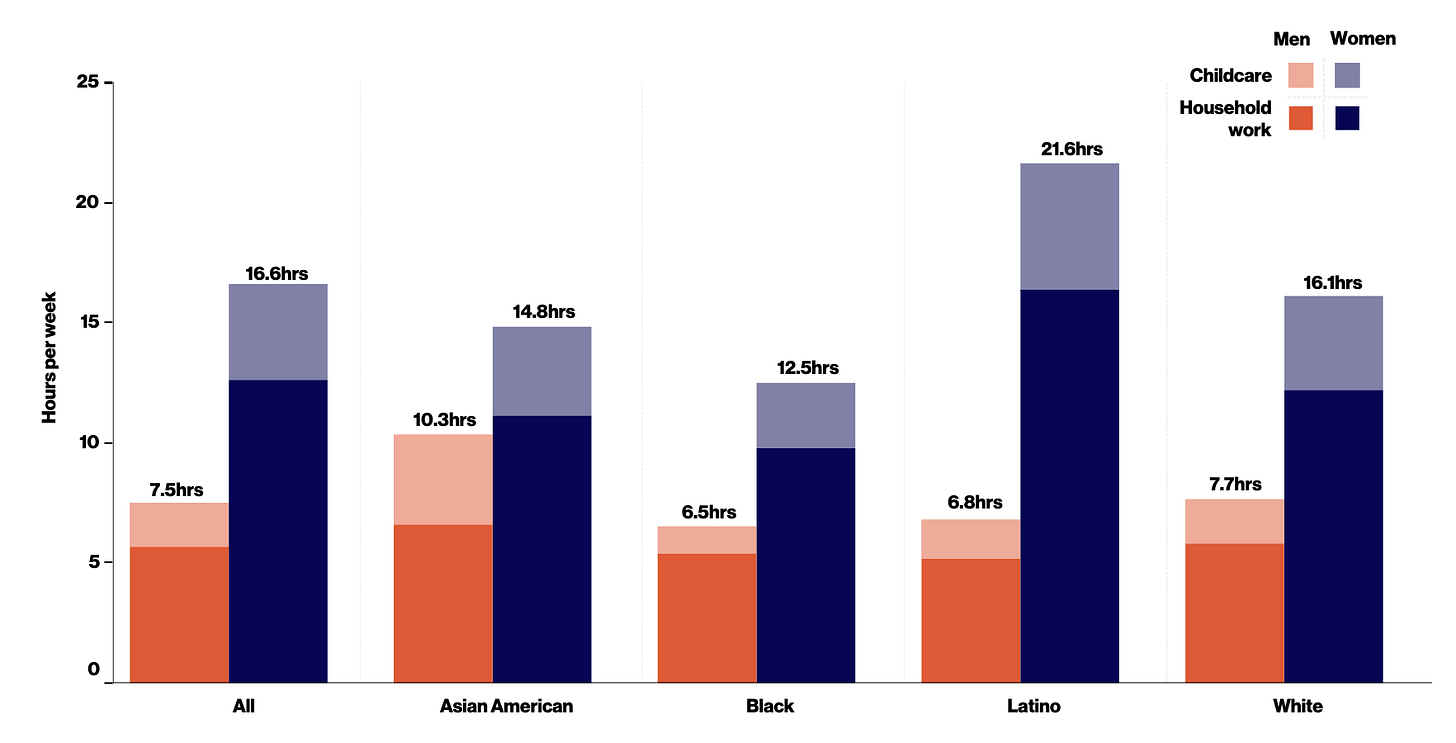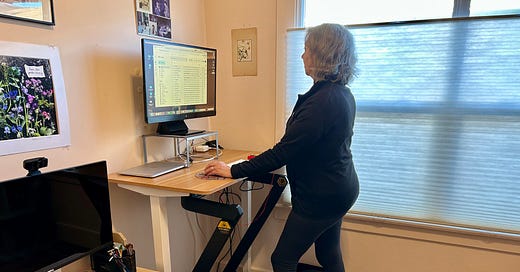The Crazy Yet Not so Surprising Reason Women Get Less Exercise than Men
Even though women benefit more from exercise than men do — who knew!
Go ahead, make my day: To make it easier for other people to find Flower Child (you know, algorithms), please click the ❤️ at the top or bottom of this newsletter. Thank you!
Here at Flower Child, during Women’s History Month I’ve been known to explore how our society treats women. I’ve written about the ways women are ignored, diminished, or left out of stuff. I’ve written about women artists, women writers, and medieval women.
But I didn’t expect to be writing about exercise.
Not till I read about an NIH study on the health benefits of exercise. Out of more than 400,000 people studied, only 33% of the women got the recommended amount of weekly aerobic exercise, compared to 43% of the men.
Great! Yet another area where women get a bum deal.
If my family were anything to go by, you’d think women get more exercise than men (not that I manage much). But it turns out that in exercise, as in so many other things, Rafael and I are outliers.
So, in the rest of America, why are women getting less exercise than men?
It’s about time
Most questions don’t have one simple answer; the exercise gap is no exception. The gap begins in childhood, when boys are more encouraged than girls to participate in sports. That tends to make them more confident about exercising, a feeling that persists into adulthood — as does the exercise gap.
Still, the biggest issue is free time. None of us have enough of it; women have less than men.
A 2024 report from the nonprofit Gender Equity Policy Institute quantified this gap, finding that American women have 13% less free time than men. The gap is especially evident among parents, but it applies to all men and women. That’s because women spend more time keeping our households functioning. Whether we have children or not, “women are significantly more likely than men to spend more time on unpaid work in the home.”
According to the report, women spend 12.6 hours per week on cooking, laundry, cleaning, and other types of housework, compared to 5.7 hours for men. When you add childcare, women spend over twice as much time as men on unpaid household-related work.

I don’t think these numbers include the “mental load” of running a household, which disproportionately falls on women. What constitutes the mental load? Deciding what to make for dinner, keeping track of whether the fridge is stocked, and creating a shopping list; arranging the family’s social life; ensuring bills and taxes are paid; coordinating household maintenance and repairs; tracking children’s schedules; getting necessary medical care for children and pets … the list goes on. And on. And on.
It’s the system, man!
Exercise is good for everyone, but the NIH study found it’s especially good for women. Apparently, over a period of two decades, women who exercise are 24% less likely to die than those who don’t, compared to 15% for men. By exercising, women can reduce our risk of a fatal heart attack, stroke, or other cardiovascular event by 36%, while men get only a 14% reduction.
Although women still live longer than men, we spend a larger portion of our lives in poor health than men do. So even if a longer life isn’t our goal, it’s worth getting more exercise.
In light of the NIH findings, most articles about the exercise gender gap recommend that women make exercise a priority. But while the numbers are compelling and might convince some of us to try harder to fit in exercise, finding the time remains a challenge.
Urging us to somehow make more time for exercise strikes me as yet another case of putting the onus for systemic problems on the individual. Overweight? Eat better; don’t challenge the “food” industry’s manipulation of our taste buds. Spend too much time on social media? Set time limits for your apps; don’t change the industry’s business model. Stressed? Meditate and journal; don’t fix the system that’s stressing you in the first place.
I’m not saying we shouldn’t eat better, limit our social media time, or meditate — while also working to fix our broken systems. I get that I should make exercise a priority and find the time to do it. But where is that time coming from?
I’ll tell you where it’s not coming from: unfettered late-stage capitalism. If you’ve been reading Flower Child, you know I’m not a fan. It’s not called a rat race for nothing; our current capitalist system, as implemented in the U.S., keeps many of us too busy and tired to exercise enough — or to do things like, you know, protest in the streets.
Our extreme income inequality means an increasing number of people have to work more than one job just to get by; over a third of Americans have second jobs. Our sprawling cities mean we spend more time commuting than is reasonable; the average American commutes for about an hour a day, and we all know people whose commutes take much longer than that. Our scarce vacation time means we rarely get a break; of the 76% of American workers who have access to any paid days off, many get just 5–10 a year (15 if they’re lucky), compared to the 20–30 days that’s typical for Europeans — and about 46% of Americans don’t even take all the scant days they’re allotted.
Improving these systems would benefit all of us, not just women. But women, given our smaller amount of free time, stand to benefit the most.
The Post-it Note Challenge
I’m not holding my breath for improvements in income equality, commute times, or paid days off. I’m not even holding my breath for men to step up and do more work around the house. But I offer, once again, one small way to address the household work inequity: the “Post-it Note Challenge.”
David Allan of CNN described what happened when his wife challenged him to write all the tasks he did on Post-it Notes, while she did the same. Not surprisingly, her pile of Post-its was much bigger than his, giving them a concrete visual representation of the labor imbalance in their home. Then, they moved the Post-its around till the piles were more even.
Try this at home! If you do, let me know what happens. Full disclosure: I haven’t done the challenge myself, and Rafael has not been eager to make it happen, likely not wanting to see the discrepancies in our piles of Post-its.
At least he’s not getting more exercise than I am. Now, please excuse me while I switch over to my treadmill desk. It’s not the ideal form of exercise, but it gives me one way to fit in some movement.
If you’ve read this far, please consider clicking the ❤️ and/or leaving a comment on this post!👇 It helps me feel like I’m not writing into the void — and gets more eyes on my writing.





I think Edie and my household might be an outlier as well. I’m pretty sure my pile of post it notes would be pretty massive! 😂
I can’t believe I didn’t realize women get less exercise than men, thanks for bringing that into my awareness! I definitely need to start the post-it note challenge in my household 🤣